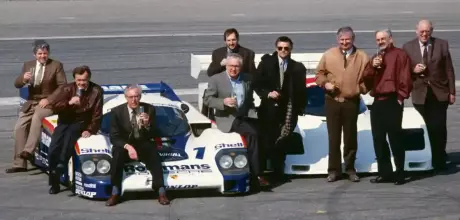Porsche’s domination of Group C in the 1980s seems almost to have been forgotten
Strangely, Porsche’s domination of Group C in the 1980s seems almost to have been forgotten, unlike the 917’s crushing victories in 1970/71 that are regularly celebrated. Perhaps Group C never captured the popular imagination in the same way as Le Mans does.
Porsche’s virtual takeover of this championship series came about when Motorsport was being wound down and the 911 had already been written out of the script by Ernst Fuhrmann, who only permitted the development the 924 GTR. This was an unpopular move both inside and outside Porsche, and contributed to Ernst’s departure. When his successor, Peter Schutz, learned that Porsche once again would be entering Le Mans – albeit aiming for a mere class – he insisted that the company fielded a potential race winner. Agile thinking at Weissach devised such a race car in three months: the 936/81 was a quickly revamped version of the car that achieved three consecutive 24 Hours victories before being pensioned off in 1978. The product of 12 weeks’ urgent resuscitation, the 936/81 – driven by Derek Bell and Jacky Ickx – scored a fairy tale victory at la Sarthe.
Success breeds success. Suddenly, top-level racing was back on Porsche’s agenda. Peter Falk was appointed director of Motorsport and work began on a car for the new Group C series, which was set to replace the World Sportscar Championship in 1982. The Porsche 956 was an aluminium monocoque honed to aerodynamic perfection under Norbert Singer’s auspices and propelled by a water-cooled, twin-turbo, 2.8-litre flat six. The first seasons of Group C were dominated by Works 956s (from 1985 it was the 962), while customer teams racing with 956 and 962s competed for the minor placings.
It was mid-decade before other manufacturers in the shape of Jaguar, Nissan and Sauber Mercedes- Benz materialised and brought real competition. By then, after six years, Porsche had withdrawn from Group C to concentrate on the American CART series. Privately entered 962s soldiered on, but lacking the resources of the Works teams, they became also-rans in Group C’s final years. Such was Porsche’s long-dominance of Group C though, that the series will always be associated with its most numerous and successful exponents, the 956s and 962s – of which over 100 were built.
On 27 March 1992, exactly 10 years after Jürgen Barth took the first 956 on to the track at Weissach, the engineers and specialists who created this remarkable racer gathered at the skid pan to raise a glass of Sekt in celebration of one of Porsche’s most underrated achievements. They are (from left to right): Fritz Springler, who learned his trade beside turbomeister Valentin Schäffer in the pioneering days with the 917 CanAm turbo; Valentin himself; director Peter Falk (seated); technicians Gerd Schmid and Helmut Schmid; Hans Mezger in the dark glasses; the incomparable Norbert Singer; Horst Reitter, the chief chassis engineer; and Eugen Kolb, who formed the aluminium coachwork. It’s a charming snapshot that captures classic teamwork by men who, without exception, spent their working lives at Porsche.


